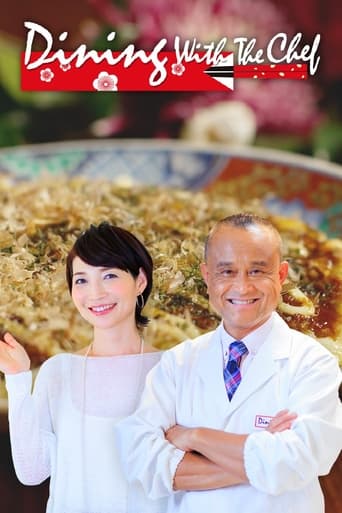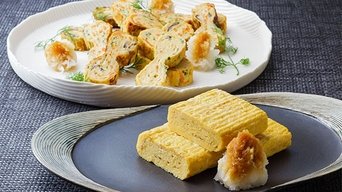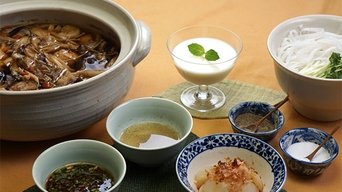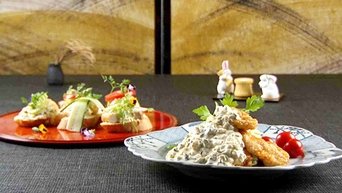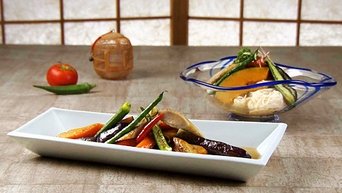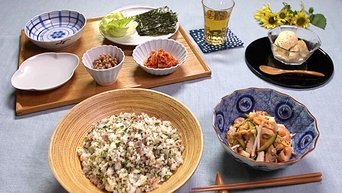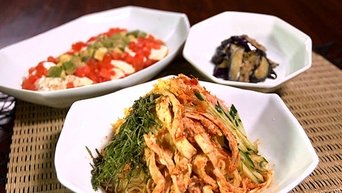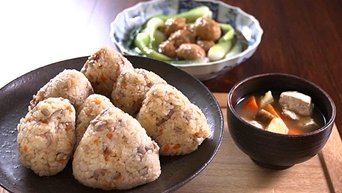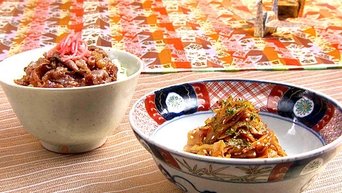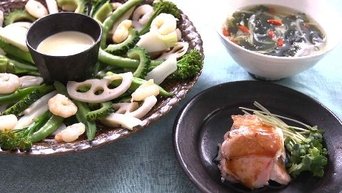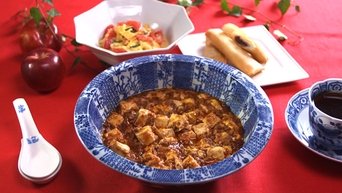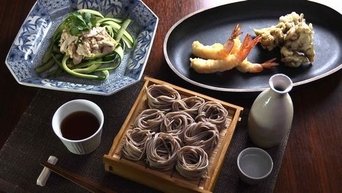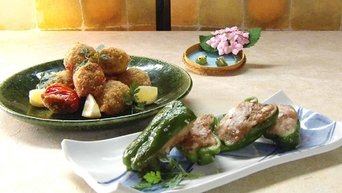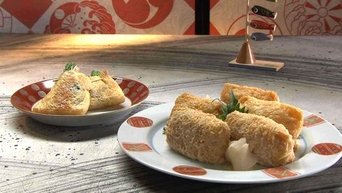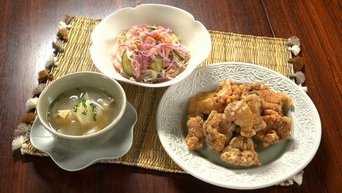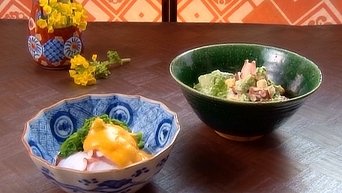Dining with the Chef Season 2
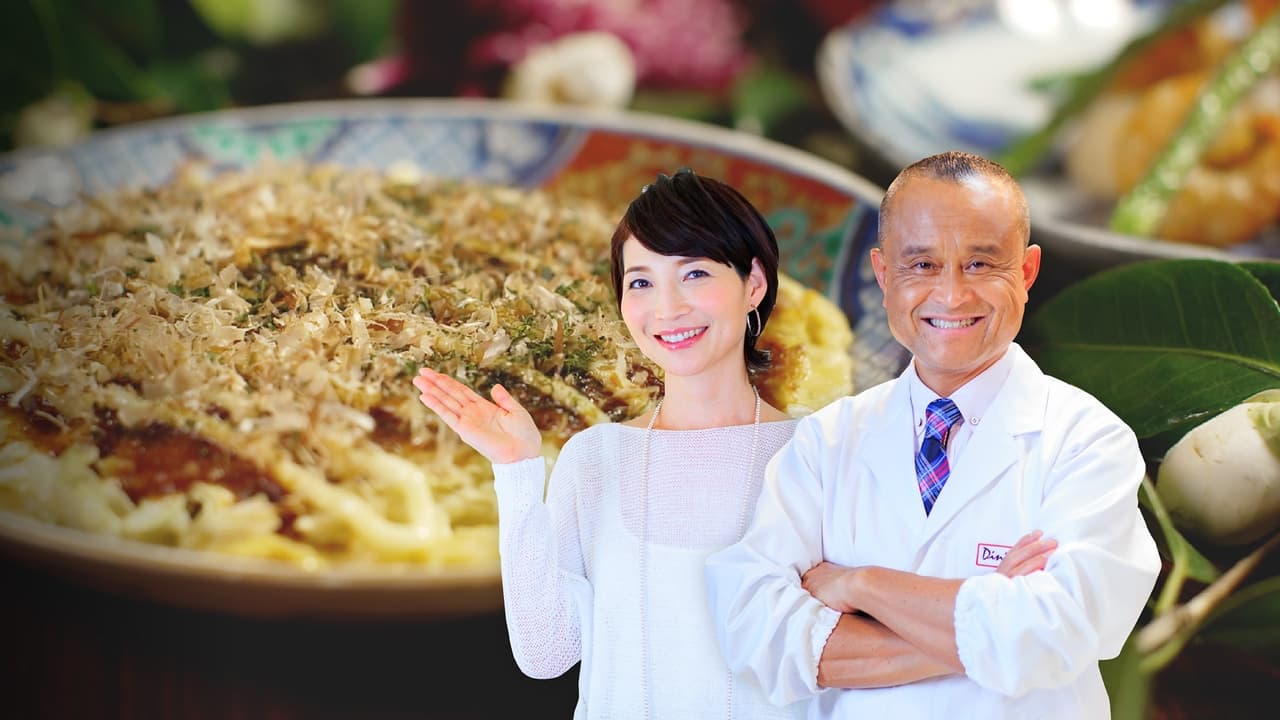
Traditional techniques and resourceful recipes! Chefs Saito and Rika, present their unique approaches to cooking delicious Japanese food.
Watch NowWith 30 Day Free Trial!
Dining with the Chef
2012 / NR
Traditional techniques and resourceful recipes! Chefs Saito and Rika, present their unique approaches to cooking delicious Japanese food.
Watch Trailer
Dining with the Chef Season 2 Full Episode Guide
The theme for this episode is Wrapping Techniques. We take a look at chakin sushi, which consists of sushi rice carefully wrapped in thinly fried egg and then colorfully decorated. Garnished with shrimp and rapini, it brings a wonderful feeling of spring to the table. The second dish is a soup that uses dashi and egg white, and creates a delightful appearance of blooming flowers.
This episode features bamboo shoots - the ingredient that symbolizes spring in Japan! We take a look at takikomi rice, as well as chawan mushi which is given a smooth, velvety texture with egg and which brings out the full umami flavor of dashi. In addition to these two fine examples of Japanese cuisine that use bamboo springs lovingly, we will also present a simple steamed fish dish.
The theme for this episode is the ever-popular gyoza. A filling of minced meat and chopped vegetables is kneaded together, wrapped in a dough skin and fried. There is an incredible variety of gyoza depending on the ingredients and cooking method used by individual restaurants or households. Rika-style gyoza use pork mince, and four vegetables including Chinese cabbage and shiso, to create a light and tantalizing flavor.
The theme for this episode is Dressing Techniques (Part 2). We will take a look at the dressed dish known as nutaae that uses a dressing made with miso, the characteristic Japanese food. The rich, golden sauce and luscious green onion produce a beautiful spring feel. Another variation is the Japanese favorite macaroni salad prepared in the nutaae style.
The theme for this episode is Dressing Techniques (Part 1). Japanese cuisine contains a magnificent array of aemono, or dressed dishes. Here we will take a look at one of such dishes known as shiraae. Vegetables and seafood, such as tuna, cuttlefish, and scallops, are colorfully dressed using a paste made from tofu. Another variation is a tofu paste and persimmon aemono, which is also wonderful as either an appetizer or dessert.
The theme for this episode is Cream Stew. A variety of delicious ingredients in a soup nicely thickened with milk, it is a popular home-cooked meal in Japan in winter. It uses seasonal oysters lavishly, and has a light flavor that goes perfectly with rice. Accompanied by a salad seasoned with sushi vinegar and a Japanese sake jelly, it is a full course of Rika's original Japanese nouvelle cuisine.
This episode we have a rice porridge created using soup stock made from dried scallop, an ingredient used in Chinese cuisine. With ginger added too, it is a perfect winter dish that will warm your body to the core. We will take a look at it together with a rich-flavored sautéed chicken with teriyaki sauce and a wonderfully nutritious egg dish that both go superbly with a light porridge.
The theme for this episode is Thickening Techniques (Part 2). We take a look at jibuni, a local dish from Kanazawa in the Hokuriku region. It uses flour to thicken the sauce which is quite unique among Japanese cuisine. As a different variation the jibuni sauce can be poured over deep-fried bean-starch vermicelli creating an attractive, colorful dish!
The theme for this episode is Thickening Techniques (Part 1). We will take a look at Fried tofu with dashi sauce, which is extremely popular both at home and at Japanese-style pubs. Enjoy the smooth texture of fried tofu covered in a thick sauce that uses plenty of dashi. As a different variation there's Yuba no Ankake, which is chopped up bean curd skin in a lovely thick sauce. Topped with vegetables it makes a wonderfully healthy dish!
In this episode we look at a warm and hearty Japanese udon noodle dish - Udon Hot Pot with a rich chicken stock base. This wonderfully nutritious hot pot, made with udon, fresh seafood and seasonal vegetables, is sure to warm you to the bone. Perfect for the company of family or friends on a cold winter's night.
This menu includes 3 dishes sure to warm you to the bone in the cold of winter. The main dish is cuisine that uses the seasonal root vegetable daikon radish with pork belly, stewed slowly until soft, and seasoned with salt and sugar. Why not try it with the Japanese liquor shochu as they go very well together.
The theme for this episode is Rolling (Part 2). We look at beef and burdock rolls, a dish that in Japan often finds its way onto the table during celebrative occasions. Burdock root is wrapped in beef, and sautéed with a sauce, creating an exquisite flavor. As a different variation, we then wrap the rolls in rice and seaweed to create futomaki (thick rolls). The perfect dish for parties!
The theme for this episode is Rolling (Part 1). We look at Rolled Dashi Omelet: egg with a lavish amount of dashi full of umami flavor, which is rolled while being fried nice and thinly. As a different variation we added vegetables and some sweetness from sugar, which creates a lovely colorful touch.
In this episode we will look at nabe cooking using autumn seasonal mushrooms. Rika will be using chicken with five different kinds of mushrooms. She will also make two types of dipping sauces. The first with a lemon flavor inspired by Vietnamese cooking, and the second is a hot sauce that uses Japanese soy sauce.
This episode features dishes that go well with a refreshing highball. The main dish is fried aji (Japanese horse mackerel), covered in crispy breadcrumbs and served with Rika's original tartar sauce made with fresh cucumber and celery.
The theme of this episode is part two of “Yoseru” (setting together and congealing). Chef Saito uses an agar stick, called kanten in Japan, to make a dish which represents clear running river water. Another dish is mizuyokan, a traditional Japanese dessert – a smooth, sweet azuki bean paste jelly made with powdered kanten.
The theme of this episode is “Yoseru”(setting together and congealing) part1. With the help of gelatin, Chef Saito makes softly-set Creamed Corn Tofu and “matcha warabi mochi”, a popular Japanese sweet dumpling.
Today's theme is "Marinating Part 2". We are making "Chicken Namban", Fried Chicken Marinated in Sweet Vinegar. Fried chicken pieces quickly become pickled in a sweet and sour marinade. They are eaten with tartar sauce. It's a type of Western-influenced, Japanese chicken dish. For one variation, the fried chicken will become an open-faced sandwich.
Today's theme is "marinating". We are learning how marinating elevates the flavor of fried vegetables by infusing them in a dashi stock and soy sauce mixture. For one variation on this dish, our chef is making a noodle dish, using marinated and fried vegetables.
Today's menu consists of 3 dishes each with its own flavorful composition. Our 1st dish is Spicy Seafood and Vegetable Salad seasoned with sweet and hot Korean miso called gochu-jang. Our 2nd dish is Green Spicy Aromatic Rice. Our last dish is black-pepper flavored dessert for the adults. These bold flavors will give you a boost, during the hot summer months!
Today, Rika introduces us to a chilled noodle dish that is a favorite of Japanese. Hiyashi Chuuka or Chilled Ramen Noodles is a classic summer dish in Japan. Rika is making Chilled Ramen Noodles as the main dish and 2 additional summer vegetable dishes.
Rika grew up in a large city named Fukuoka. It is considered to be one of Japan's culinary destinations with everything from delicious street food to high-end cuisine. Today, she is making 3 dishes and all of them are local Fukuoka specialties.
Today's theme is"Itameni Quick Braising Part 2". We are going to learn this technique along with kimpira. Kimpira is one of the most popular dishes in restaurants as well as at home. Chef Saito is using lotus root instead of burdock root today, so that we can enjoy the crunchy, fun texture. By using the same technique and seasonings as kimpira, Chef Saito is going to make Gyudon, a beef rice bowl. Let's try cooking!
Today's first dish is Chikuzen -style Chicken and Vegetables. When you quick-braise the food with soy sauce, it will turn to a beautiful caramel color. A bright green element like green beans adds a great contrast. For the variation, chef Saito will use the chicken and vegetables for making stir-fried rice.
Rika will introduce healthy attractive Japanese party dishes. The appetizer is vegetable finger food salad, served with savory Japanese dipping sauce. The roast pork is presented sashimi-style with soy sauce-based sauce. Enjoy your weekend party at home with these wonderful dishes!
Ma Po Tofu is a representative Sichuan dish. Ground meat and tofu can be enjoyed with spicy chili peppers. Today, Rika is making 3 dishes, featuring Tokyo-style Chinese cuisine. Rika's Ma Po Tofu has fluffy tofu pieces and the spiciness and the sweetness goes well together.
Buckwheat flour is made into soba, the buckwheat noodle, and loved in Japan. Zaru-soba, the chilled soba served with cold dipping sauce is the best way to enjoy its scent and texture simply. Let's get a taste of Japanese' favorite popular noodle with its apt side dish, tempura.
Japanese-style, stuffed peppers are popular menu among kids and adults, which are half-cut grilled pepper stuffed with ground pork. For a applied variation on the dish, the whole stuffed peppers will be battered and deep-fried to a delicious, crispy texture.
Today's theme is stuffing. First dish is Inari Sushi, an example of a casual dish at home. Inari Sushi is made with abura age, which is seasoned with sugar and soy sauce, and it is stuffed with seasoned rice. It is a very popular item for picnics or box lunches.
Japanese love to serve fried chicken with beer. Rika's fried chicken, is extra crispy, with a tasty batter. A perfect combination of a fried dish, salad, and soup! Enjoy with some delicious Japanese beer.
Today's first dish is the octopus and rapini with egg vinegar dressing. This is a popular vinegary sashimi dish in Japan, and a perfect spring dish. Next dish is octopus and avocado caesar salad. The red octopus is outstanding in contrast to the pale greens. The avocado mingles with the caesar dressing, and it's so good!
Today's dish is sashimi with tuna and squid. Sashimi is the supreme form of Japanese cuisine. To achieve the simple beauty, there are many tips and techniques. Thickly cut tuna and thinly cut squid are arranged on a plate. The sashimi is then arranged with decoratively cut fresh vegetables.
Rika will show us how to make three different sea food dishes that makes a casual dining perfect. Today's main course is steamed Sea Breams with clams and potatoes on the side. Potatoes are perfectly steamed with Sea Breams and clams in sake based broth which makes all the ingredients taste even better.
Free Trial Channels
Seasons


